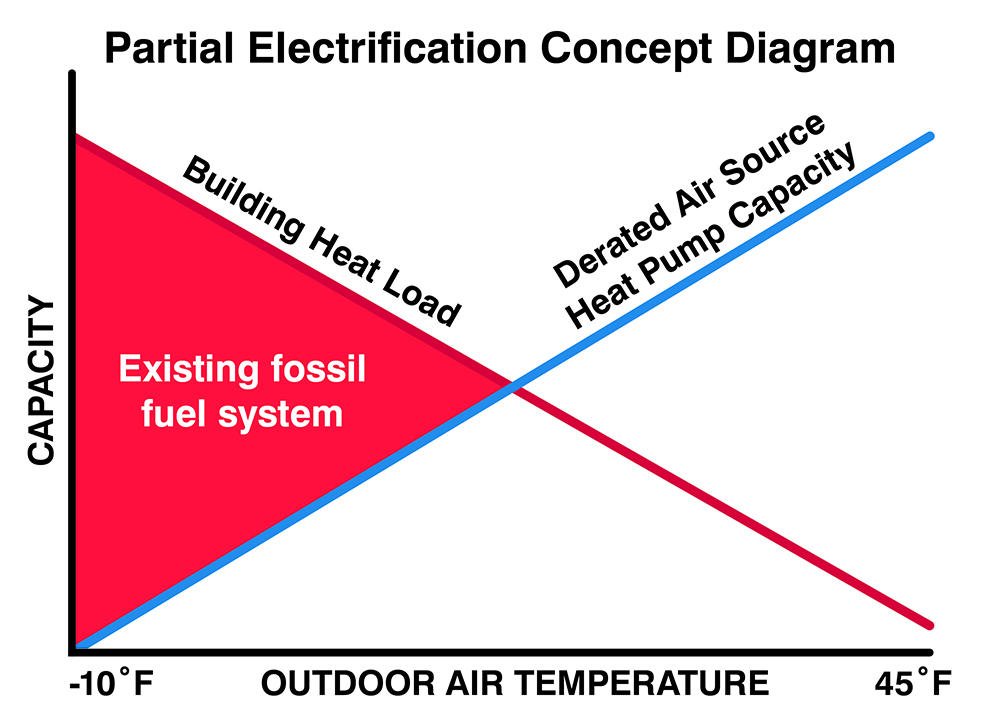


As the real estate industry continues to pursue ambitious carbon reduction goals, many commercial and municipal building owners are facing growing pressure to electrify their heating systems. Replacing fossil fuel-fired boilers with 100% electric heating systems sounds like a straightforward solution and one that aligns with climate policies and future energy grids. But for existing buildings, particularly in cold climates like ours, the path to decarbonization is rarely that simple.
In New England, going fully electric is often not the most economic, resilient, or sustainable approach. This is especially true when retrofitting older buildings where structural constraints, electrical service limitations, and unpredictable winter weather can complicate the equation. Instead of prescribing a one-size-fits-all solution, we argue that promoting a more holistic, performance-based approach may be more logical and cost-effective, considering each building’s unique characteristics and embracing hybrid systems when appropriate.
The Promises and Pitfalls of Full Electrification: Air source heat pumps have made significant efficiency gains in the last decade. When paired with cleaner grid electricity, they offer a lower-carbon alternative to fossil fuel-fired systems and provide year-round heating and cooling. But performance and efficiency drop markedly as outdoor temperatures fall - exactly when New England buildings need heat the most.
The coldest New England winter days require a lot from air source heat pump systems. To perform adequately, the system’s heating capacity must be substantially greater than its rated capability. This often means costly upgrades to the building’s electrical infrastructure, new service connections, switchgear, and backup systems. In urban settings, it may even trigger permitting delays or capacity constraints with the local utility.
Hybrid Systems: When Good Enough Can Be Better than Perfect: Rather than forcing full electrification onto every retrofit project, a hybrid heating system that includes a high-efficiency electric heat pump paired with a fossil fuel backup can offer a more balanced and cost-effective path to carbon reduction. The idea is to let the electric system handle around 90% of the building’s peak heating load while allowing the existing fossil fuel heating system to meet the heating load of the few coldest days. We have seen electrification projects fail to get built due to high conversion costs that would have passed financial muster had the existing fossil fuel heating plant been allowed to provide heating during the coldest hours of the year. Better substantial partial electrification than none.
This approach can approach maximized carbon savings while minimizing disruption and risk, allowing building owners to:
• Reduce the amount of heat pump capital required by a factor of 30-50% while still providing over 90% electrification;
• Reduce or avoid expensive electrical upgrades by downsizing electric system components;
• Provide a backup source of heat should the heat pump fail;
• Preserve embedded capital in functioning fossil fuel equipment that still has useful life; and/or
• Phase in electrification as grid reliability and renewable penetration improve over time.
In other words, it’s not about abandoning electrification - it’s about using it smarter.

The Holistic View: More Than Just the Heat Source: Too often, retrofit projects fixate solely on the heating equipment. But real carbon reduction comes from looking at the whole building as a system. That means:
• Improving the building envelope with insulation and air sealing to reduce overall heating load;
• Right-sizing equipment for actual performance rather than code minimums;
• Optimizing controls to sequence electric and backup systems intelligently; and
• Monitoring real-world performance to ensure targets are being met and adjusted as needed.
In addition, decision-makers should consider the carbon intensity of the local electric grid. In most of New England, electricity is still mostly generated by natural gas and oil, which means a fully electric system currently has a higher operational carbon footprint than many people realize. Time-sensitive carbon modeling and load shifting strategies (e.g., using thermal storage or pre-heating buildings) are increasingly important to getting this right.
Policies and Incentives Need to Evolve: Many current decarbonization policies take a binary view: fossil fuels bad, electrification good. While the intent is noble, the unintended result can be a rush toward prescriptive – dare we say myopic - solutions that overlook lifecycle costs, operational reliability, or real carbon impact.
We hope that incentive programs begin to recognize and support hybrid solutions when they deliver the best outcome. Building codes and energy standards should allow for flexibility when they improve overall system performance and resilience. And more education is needed - for building managers, engineers, and even code officials - to understand that decarbonization is a journey, not a switch.
We are at a critical turning point in how we heat our buildings. Electrification will absolutely play a leading role in the decarbonized future. But forcing full electrification on every existing building, regardless of climate, infrastructure, or economics, risks undermining our goals.
Let’s prioritize smart electrification and think holistically. And let’s give building owners the tools and the flexibility to reduce emissions without sacrificing performance or financial viability. A hybrid heating system might not be the endgame, but for many buildings, it’s the right next step.
Della Donahue is a senior job captain, Cole Gorham is a mechanical engineer and Scott Henriques is senior team leader, at Weston & Sampson, Foxborough, Mass.
